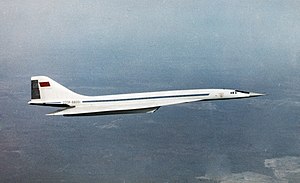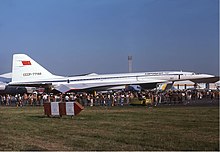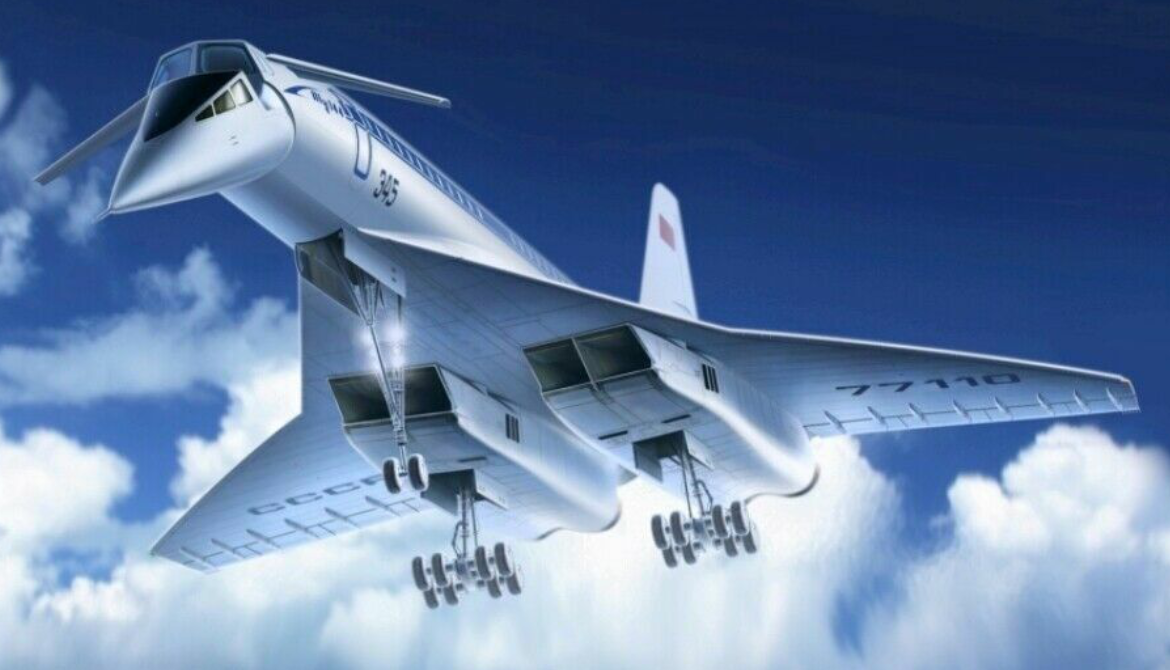Tupolev Design Bureau
Tupolev Tu-144 Charger
 |
|
| Tu-144 prototype in flight on 1 February 1969 | |
| Role | Supersonic airliner |
|---|---|
| National origin | Soviet Union |
| Manufacturer | Voronezh Aircraft Production Association |
| Design group | Tupolev OKB |
| First flight | 31 December 1968 |
| Introduction | 26 December 1975 |
| Status | Retired from passenger service (1978) Retired from commercial service (1983)Retired (1999) |
| Primary users | Aeroflot Ministry of Aviation Industry NASA |
| Produced | 1967–1983 |
| Number built | 16 |
|
|
.
History Public Joint Stock Company Tupolev,
Tupolev Tu-144 Charger SST
First flight 31 December 1968 Introduction 26 December 1975

The Tu-144 was the world's first commercial supersonic transport aircraft with its prototype's maiden flight from Zhukovsky Airport on 31 December 1968, two months before the British-French Concorde. The Tu-144 was a product of the Tupolev Design Bureau, an OKB headed by aeronautics pioneer Aleksey Tupolev, and 16 aircraft were manufactured by the Voronezh Aircraft Production Association in Voronezh. The Tu-144 conducted 102 commercial flights, of which only 55 carried passengers, at an average service altitude of 16,000 metres (52,000 ft) and cruised at a speed of around 2,200 kilometres per hour (1,400 mph) (Mach 2). The Tu-144 first went supersonic on 5 June 1969, four months before Concorde, and on 26 May 1970 became the world's first commercial transport to exceed Mach 2
Design


Along with early Tu-134s, the Tu-144 was one of the last commercial aircraft with a braking parachute. The Tu-144 was not fitted with any reverse thrust capabilities, and so the parachute was used as the sole alternative. A prototype without passenger seats was fitted with ejection seats for pilots.
- Materials
The aircraft was designed for a 30,000-hour service life over 15 years. Airframe heating and the high temperature properties of the primary structural materials, which were aluminium alloys, set the maximum speed at Mach 2.2.: 49 15% by weight was titanium and 23% non-metallic materials. Titanium or stainless steel were used for the leading edges, elevons, rudder and the rear fuselage engine-exhaust heat shield
0
KmCeiling
0
KmCombat RANGE
0
MachAircraft Speed
0
Max Crew
Photo Gallery
Public Joint Stock Company Tupolev,
Tupolev Tu-144 Charger SST
First flight 31 December 1968 Introduction 26 December 1975


Public Joint Stock Company Tupolev,
Tupolev Tu-144 Charger SST
First flight 31 December 1968 Introduction 26 December 1975
General Info
-
-
-
-
- Crew: 3
- Capacity: 150 passengers (11 first class & 139 tourist class)
- Length: 65.7 m (215 ft 7 in)
- Wingspan: 28.8 m (94 ft 6 in)
- Height: 12.55 m (41 ft 2 in)
- Wing area: 506.35 m2 (5,450.3 sq ft)
-
-
-
Powerplant
-
-
-
- Empty weight: 99,200 kg
- Gross weight: 125,000 kg)
- Max takeoff weight: 207,000 kg
- Fuel capacity: 93,000 kg
- Powerplant: 4 × Kolesov RD-36-51 turbojets, 240 kN (54,000 lbf) thrust each
-
-
-
Performance
-
- Maximum speed: 2,500 km/h
- Maximum speed: Mach 2.15
-
Cruise speed: 2,125 km/h (1,320 mph, 1,147 kn) *
Cruise Mach number: M2 - Range: 6,500 km
- Service ceiling: 20,000 m (66,000 ft)
Links to Youtube & Others
Between 1970 and December 2016 there were 110 serious incidents involving the Tu-154, including 73 hull losses,
with 2,911 fatalities.
Tupolev Design Bureau Tupolev Tu-144 Charger
On this site you can find all the information about the first supersonic airliner that flew, the Tupolev Tu-144
Youtube Link
In de jaren 1960, concurreerden de ontwerpers van de Britse/Franse Concorde en de Russische Tupolev Tu-144 om te zien wie het eerste supersonische passagiersvliegtuig in de lucht zou krijgen.












